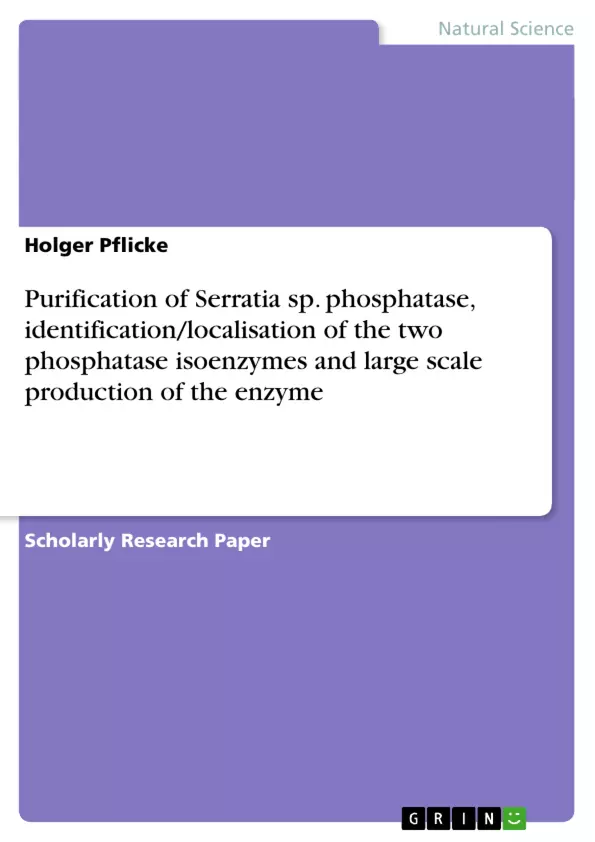This study is part of the project "Bioremediation of Nuclear Wastes by Biomineralization Processes" which uses an established biomineralization process (using Serratia sp.) for the removal of uranyl ions as hydrogen uranyl phosphate (HUP). HUP will be tested as a host crystal for intercalative ion exchange or co-crystallative removal of problematic nuclide fission products (FP) like 60Co, 90Sr and 137Cs using "cold" isotopes in Birmingham in parallel to tests in Korea using real wastes. Metal uptake is mediated via a cell-bound phosphatase that liberates inorganic phosphate, which precipitates with heavy metals as cell-bound metal phosphate, thus depositing the uranyl phosphate "host crystal" for the sequestration of the FP. The phosphatase is localised periplasmically and also within the extracellular polymeric matrix (EPM). Successful operation of the process depends on the correct localization of the enzyme into the extracellular matrix. It can be speculated that the periplasmic enzyme pool is a reservoir awaiting export and other studies have suggested the presence of two phosphatase isoenzymes, which differ in their chemical- and radiostability but are not yet assigned to either phosphatase pool or EPM since they are immunologically cross-reactive. The two phosphatases (designated CPI and CPII) are very similar but distinguished simply using cationic (CPII retained) and anionic (CPI retained) ion exchange resins.
This study will concentrate on the production of phosphatase CPI and CPII which will be differentiated by enzyme partial purification (exocellularly-localised and residual whole-cell enzymes) followed by quantification of their cation exchange (CPII) and anion exchange (CPI) resin binding. Large scale biomass preparation for bulk enzyme production for enzyme structural studies (X ray crystallography using the Korean Synchrotron Facility) will use the 600 L facility in the pilot plant in the School of Chemical Engineering University of Birmingham.
The overall objective of the project is to promote the localisation of the more radiostable isoenzyme (CPI) into the exocellular matrix for maximum production of uranyl phosphate in the presence of the high-active nuclide fission products and to understand this radiostability in terms of the associated water in the active site pocket of this novel phosphohydrolase.
Inhaltsverzeichnis (Table of Contents)
- PROJECT TASK
- ACKNOWLEDGEMENTS
- CONTENTS
- ABBREVIATIONS
- Introduction
- Aim of the study
- Basics
- Materials and methods
- Materials
- Chemicals
- Organism
- Media
- Minimal Medium
- General Methods
- Growth of microorganisms
- Enzyme purification
- SDS-PAGE
- Results and discussion
- Growth of Serratia sp. N14
- Purification of Serratia sp. N14 phosphatase
- Summary and prospects
- Bibliography
- APPENDICES
- Appendix I Bradford assay
- Appendix II Bicinchoninic acid (BCA) protein assay
- Appendix III Phosphatase activity assay
- Appendix IV SDS-PAGE
- Appendix V Chromatography stages
- Purification and characterization of phosphatase isoenzymes from Serratia sp.
- Investigation of the radiostability of phosphatase isoenzymes.
- Optimization of phosphatase production and localization for enhanced bioremediation.
- Understanding the role of phosphatase in heavy metal sequestration.
- Development of large-scale production methods for phosphatase.
- Introduction: This chapter introduces the bioremediation process for nuclear waste using Serratia sp. and highlights the role of phosphatase in the process. It also provides background information on the two phosphatase isoenzymes and their potential applications in bioremediation.
- Materials and methods: This chapter details the materials used in the study, including chemicals, organisms, and media. It also describes the general methods employed, such as microbial growth, enzyme purification, and SDS-PAGE analysis.
- Results and discussion: This chapter presents the results of the study, focusing on the growth of Serratia sp. and the purification of phosphatase isoenzymes. It also discusses the findings and their implications for bioremediation.
Zielsetzung und Themenschwerpunkte (Objectives and Key Themes)
This study focuses on the purification and production of phosphatase isoenzymes from Serratia sp., a bacterium used in a bioremediation process for nuclear waste. The project aims to understand the role of these isoenzymes in the sequestration of heavy metals and to promote the localization of the more radiostable isoenzyme into the extracellular matrix for optimal bioremediation efficiency.
Zusammenfassung der Kapitel (Chapter Summaries)
Schlüsselwörter (Keywords)
The primary focus of this study is on the purification, characterization, and production of phosphatase isoenzymes from Serratia sp. for application in bioremediation of nuclear waste. Key concepts include phosphatase activity, radiostability, isoenzyme localization, biomineralization, and heavy metal sequestration.
- Quote paper
- Holger Pflicke (Author), 2003, Purification of Serratia sp. phosphatase, identification/localisation of the two phosphatase isoenzymes and large scale production of the enzyme, Munich, GRIN Verlag, https://www.grin.com/document/18268



